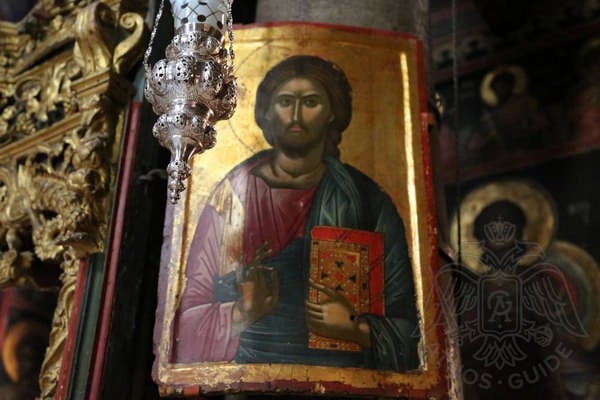History and present days
The Stavronikita Monastery, one of the smallest monastic structures in Mount Athos, is located on a high rock that projects out into the sea. The floor plan of the monastery is quadrilateral. The wings are three-storeys high. The eastern wing has balconies. The west wing has arches on its inner face and ceramic decoration. It was restored in 1986-88. The north wing has three-storeys on its internal face and a raised ground floor. Its exterior is characterized by many balconies and carved windows. The south wing has two storeys. On this side there is located the entrance and the tower. Its form was shaped according to the morphology of the terrain. The enclosed interior space creates an atmosphere of intimacy, though the exterior facades retain their fortified character. Its position and dimensions make it one of the most elegant architectural structures. Many travelers have likened the monastery to an Italian castle. The tower, which probably preexisted from the monastery, was used as an observatory and is still visible today.
 The placement of the monastic structure was based on the need of protection from pirate raids. However, the construction of it on the top of a rock caused serious static problems after the earthquake of Ierissos (1932). The cracks created were treated with a large-scale intervention (1996-2000).
The placement of the monastic structure was based on the need of protection from pirate raids. However, the construction of it on the top of a rock caused serious static problems after the earthquake of Ierissos (1932). The cracks created were treated with a large-scale intervention (1996-2000).
At the base of the cliff towards the sea, one can see the material used to support the rock and the architectural structure.
History
The earliest reference to the monastery is found in a document of 1012 (archive of the Holy Monastery of Great Lavra) signed by the monk Nikephoros of the “Stravonikita”. This is used as evidence to the claim that the monastery took its name from an unidentified monk Nikitas, who was a one-eyed or cross-eyed monk (from the word “στραβός”-“stravos” which means blind). However, an anagram created the name of the monastery as we know it today. According to another theory, the name refers to the feast of the Holy Cross (“σταυρός” — “stavros” which means cross) and that of the great martyr Nikitas, commemorated the following day (15 September). The current form of the name dates from 1018-19.
The foundation of the monastery dates back to the second half of the 10th century. Thus, Stavronikita Monastery belongs to the group of the first Athonite communities (Great Lavra, Vatopaidi, Iviron). However, its historical root was quite different. The monastery was destined to be both isolated and reborn from its foundation. As it seems, it was destroyed by the raids of Catalans (14th century) and, according to the Athonite rules, it came under the jurisdiction of the Protos. He conceded it to the Koutloumousiou Monastery, on the condition that the monks would take care and restore the ruined monastic structures. Indeed, the monastery was renovated. It later came back to the jurisdiction of the Protos and was granted as a kathisma to the Philotheou Monastery, which was already using its land.
In 1533, the monk Gregory, abbot of the Monastery of Gyromeri (Thesprotia), requested and bought the ruins of Stavronikita Monastery in order to restore it. He built cells, created the walls that surround the community and repaired the katholikon. At his request, the Ecumenical Patriarch Jeremiah I issued a sigil confirming its renovation and its property. The small church of Phacenos was incorporated into the Stavronikita Monastery at that same period.
Gregory died shortly afterwards without having completed his work. Patriarch Jeremiah (1522-46) completed the renovation and was therefore considered the second and principal patron of the monastery.
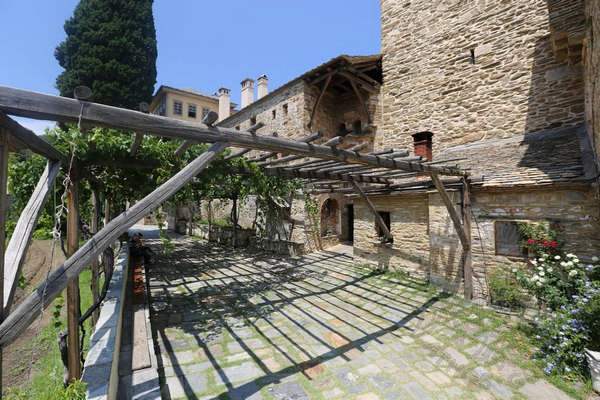
In 1546, the construction of the new katholikon, on the same place and in the same dimensions as the old one, was completed. The katholikon was built and decorated with exemplary frescoes of Theophanes the Cretan. At the end of the 17th century an arched aqueduct was built at the expense of the Wallachian ruler Serban Kantakouzenos (1679-88). The ruler of Wallachia Gikas (1727-40) also donated the Monastery of the Holy Apostles in Bucharest to the Stavronikita community as a metochion. The Stavronikita Monastery, which in the early 17th century was converted into an idiorrhythmic community, remained one of the poorest in Mount Athos. The monks had to cope with the devastation caused by three great successive fires (1607, 1741, 1879), as well as the general desolation and the economic difficulties brought about by the entry and settlement of thousands of Ottoman soldiers in December 1821. Almost 80% of the monastic population left the peninsula at that time, while four monasteries were completely deserted. Further financial difficulties were caused by the expropriation of the monastery’s property by the Greek state in favor of the refugees that had just arrived in the Greek territory (1927-28).
In the early 1960s, the monastery was forced to sell a very profitable property in Kassandra. Today, in this place it is located the hotel called “Sani”.
In 1965 there were 11 monks, while in 1967 there were left only 4. The administration decided to help the population of the monastery grow with a group of monks that were living in the Iberian Skete of Saint John the Forerunner. The conversion of the monastery into a commune in 1968 was made by a sigil of the Ecumenical Patriarch Athenagoras I. The reign of Archimandrite Basil (1968-90) changed the historical course of the monastery and marked the beginning of the revival of the Athonite monasticism, the increase of the monastic population with new groups of monks and the return of the monasteries to the cenobitic system. In 1990, monks from Stavronikita Monastery were transferred to the Monastery of Iviron, under the orders of the Archimandrite Basil. There they restored the cenobitic system of the monastic community.
The monastery was home to the holy new martyrs Luke of Mytilene († 1802, Mytilene) and Euthymios of Peloponnese († 1814, Constantinople).
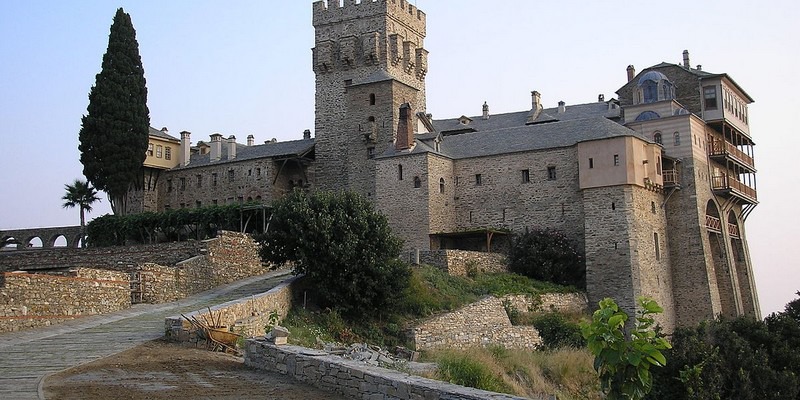
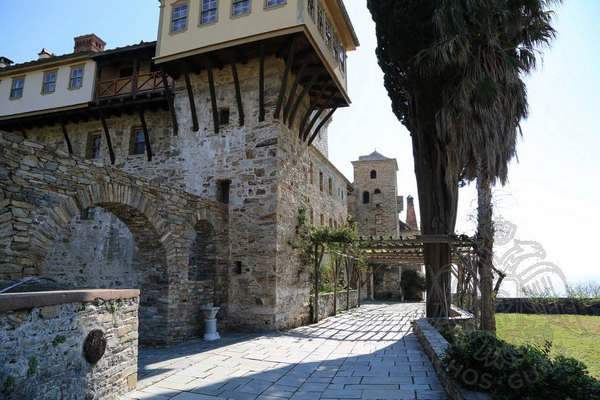
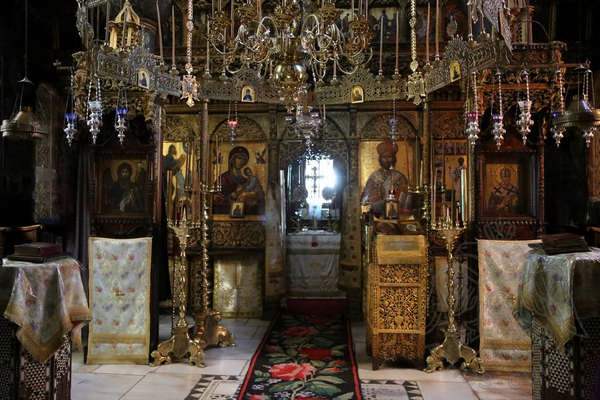 The iconostasis (1743) is wooden, gilded and very high. It bears the famous icons of the Dodekaorton, the Crucifixion and other works of Theophanes the Cretan, that apparently adorned the older iconostasis. The marble floor, the chandeliers, the carved analogues and the scant light that enters through the windows of the dome all contribute to the creation of a prayerful atmosphere.
The iconostasis (1743) is wooden, gilded and very high. It bears the famous icons of the Dodekaorton, the Crucifixion and other works of Theophanes the Cretan, that apparently adorned the older iconostasis. The marble floor, the chandeliers, the carved analogues and the scant light that enters through the windows of the dome all contribute to the creation of a prayerful atmosphere.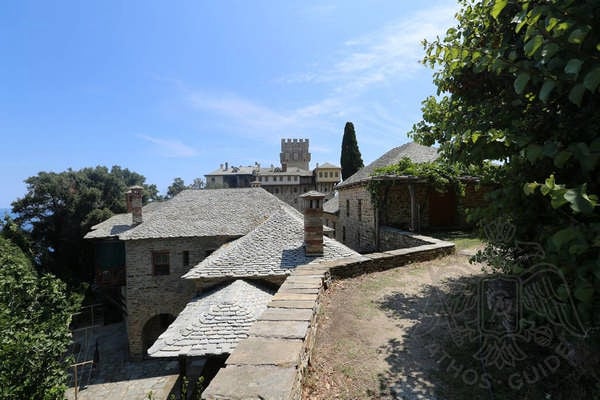 The trapeza is on the first floor of the south-eastern wing. It is directly connected to the chapel of Saint John the Baptist. Above the entrance there is an inscription of 1744. Its frescoes are the work of Theophanes.
The trapeza is on the first floor of the south-eastern wing. It is directly connected to the chapel of Saint John the Baptist. Above the entrance there is an inscription of 1744. Its frescoes are the work of Theophanes.